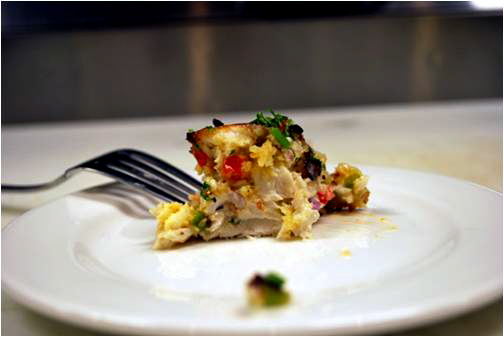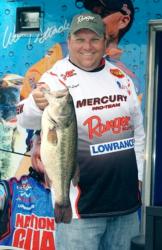Back Story: If you can’t beat ’em, eat ’em

Travis Loyd doesn’t want to think about carp when he goes bass fishing, but sometimes he can’t help it. At the Walmart FLW Major at Beaver Lake a couple of weeks ago, visions of Asian carp leaped into Loyd’s mind even as he was trying to win the event. He wound up finishing 35th, about a pound and a half out of making the Saturday cut but good enough for a $10,500 check, and perhaps he would have done better had he not been preoccupied with thoughts of carp.
It’s understandable. In a manner of speaking, Asian carp are Loyd’s day job. As deputy director of the Illinois Department of Natural Resources, their eradication is part of his mission, and he’s been very smart about how to go about it. Though bighead and silver carp have become nuisances throughout the  Mississippi River drainage, Loyd also sees the advantages that they present as sources of human nutrition – for a lot of people.
Mississippi River drainage, Loyd also sees the advantages that they present as sources of human nutrition – for a lot of people.
The sheer biomass of Asian carp, be they bigheads or silver, in the Mississipppi River drainage is staggering. We’ve all seen those YouTube videos of thousands of silver carp leaping sky-high out of the water as boats approach. Most of these flying torpedoes live in an Illinois river, stream or canal. Adult fish range between 30 and 100 pounds each, depending on species and the availability of food (plankton). But they’re carp, you say…what good are they?
Plenty, as it turns out. Since Asian carp became a big problem in Illinois waterways and Loyd was tasked with helping to find a solution, he discovered that, given the right processing and preparation, Asian carp are darn good to eat. That conclusion led the 41-year-old father of three boys to a brainstorm: why not set up a program that serves humanity while also alleviating the glut of nuisance fish in state waters? The answer was Target Hunger Now, which has already provided thousands of meals for shelters throughout Illinois. And given that there is probably more carp meat than hungry mouths in the state, Loyd figures the program he developed could go national.
“The Department of Health and Human Services has already affirmed that Asian carp are among the cleanest fish swimming,” notes Loyd, who has fished FLW tournaments since the days of the Red Man circuit back in the 80s. “These are prepared a little differently – either bake or steam them first to remove the `Y’ bones – but the meat is big white flakes that aren’t fishy tasting at all and can be prepared much the same as a crab cake. It’s the most incredible taste and people rave about it.”
A couple of Illinois processors take all the carp that DNR removal teams bring them and render much of the flesh into something resembling in taste and texture those fish sticks you were treated to every  Friday night when you were a kid. However, the carp can be processed in any ready-to-eat form that is practical.
Friday night when you were a kid. However, the carp can be processed in any ready-to-eat form that is practical.
The first partakers in the Target Hunger Now project were a group at the Hessed House soup kitchen in Aurora, Ill. Loyd organized the dinner in 2011 and the diners’ reactions convinced him he was on to something. Along the way, he made the acquaintance of a Louisiana chef, Phillipe Parola, who shared Loyd’s vision. In the past year or so, the pair have teamed up to orchestrate several demonstration meals. This week, the Congressional Black Caucus will be provided with a meal of Asian carp in Washington, D.C. Later, Loyd and Parola some of the latter’s best carp dishes will make an appearance at the prestigious Taste of Chicago festival. As Loyd sees it, if all goes well, Target Hunger Now could turn the carp lemon into lemonade.
“Our scientists and biologists agree that we need to eradicate Asian carp in our waterways,” says Loyd, “and nobody is arguing against that. But we see a dual-purpose aspect here. We can eradicate them, or at least reduce their numbers substantially, and feed people at the same time. About 25 percent of an Asian carp becomes nutritional meat and you can provide a person with a good meal with 6 ounces of carp. So 100 pounds of carp provides 25 pounds of meat, or enough fish for about 65 meals. That’s providing good protein cheaply to a needy person, and protein is expensive to come by otherwise.”
 Of course, there is the issue of the fish’s name. “Carp” isn’t a word that shows up well on a menu or typically makes taste buds tingle. But Parola thinks he has an answer for that, too. In the business world, they call it rebranding, and even fish marketers understand that giving certain fish new names helps make them more palatable to the public. Hence, the Patagonian toothfish became the Chilean sea bass, the slimehead morphed into the orange roughy, the gizzard fish transformed into the whitefish and the Asian carp changed into – tah dah – the silverfin.
Of course, there is the issue of the fish’s name. “Carp” isn’t a word that shows up well on a menu or typically makes taste buds tingle. But Parola thinks he has an answer for that, too. In the business world, they call it rebranding, and even fish marketers understand that giving certain fish new names helps make them more palatable to the public. Hence, the Patagonian toothfish became the Chilean sea bass, the slimehead morphed into the orange roughy, the gizzard fish transformed into the whitefish and the Asian carp changed into – tah dah – the silverfin.
Parola, a French emigre, created the “silverfin” moniker as well as the catchy phrase that pretty well sums up Travis’s gameplan for Asian carp: “if you can’t beat ’em, eat ’em.” Parola’s inspiration came after he was struck in the leg by a jumping carp (one of the fish’s less endearing names) while traveling along a Louisiana bayou. He formed a company called Silverfin Promotions, copyrighted the name “silverfin,” and now travels around the country helping people such as Loyd deal with their carp problems. Mainly, Parola’s solution involves cooking and consuming the fish, and Travis is on the same bandwagon.
It might be too much to expect that Asian carp – er, that is, silverfins – will become the next big culinary hit, but who can say? Before Paul Prudhomme of blackened redfish fame came along, redfish didn’t get much respect in the kitchen. If Loyd and Parola can sell the notion that the prolific silverfins are similarly delicious sources of nutrition, we’ll be able to have our carp and eat them, too.
.